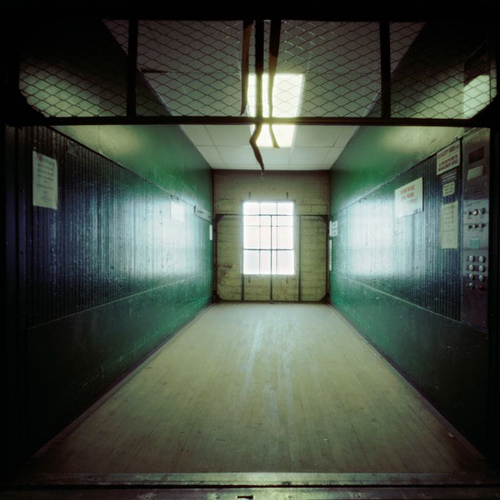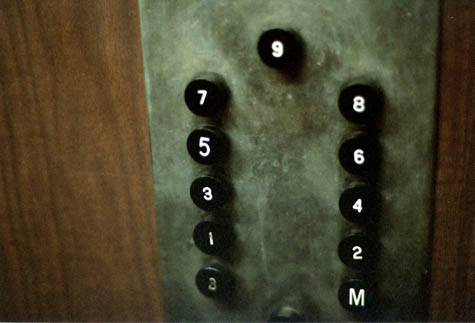Vertical Transport Through Architectural Space
 [Image: A cargo elevator beautifully shot by po1yester].
[Image: A cargo elevator beautifully shot by po1yester].Further proof that elevators have been ignored for too long in contemporary building design – after all, they are moving rooms and could be put to use as something other than mere vertical transport through architectural space – even Harrods, the London department store, is (temporarily) updating its lifts.
According to the Guardian, Harrods is about to open Lifted, "the world's first exhibition to be displayed in elevators" (a wild over-statement that is, in fact, wrong). The elevator-based exhibition will include work by "Oscar-winning composer Michael Nyman and visual artist Chris Levine."
- Levine's "Sight" lift will feature a light sculpture using Swarovski crystals and lasers to immerse passengers in mesmerising patterns once the doors close. Nyman's "Sound" composition aims to trigger feelings of confinement. The "Smell" lift, designed by Aroma Co, emits smells such as pomegranate and fresh laundry via wall-mounted buttons, while the tactile "Touch" lift was devised by the Royal National Institute for the Blind.
The "Sixth Sense" lift, however, created by author and "cosmic ordering" expert Bärbel Mohr, encourages customers to send wishes to the universe and "reconnect with their inner self".
In other words, if elevators usually take up, say, one-twentieth of a building's internal space, could you flip that ratio – and end up with just one stationary floor somewhere hanging out up there inside a labyrinth of elevators?
You have a job interview on that one, lone floor in a half an hour's time – but you can't find the place. You're moving from elevator to elevator, going down again and stopping, then stepping across into another lift that takes you up four floors higher than you'd expected to be – before you're going down again, confused. You hear other elevators when you're not moving, and it's impossible to locate yourself amidst that system of moving rooms. The only floors you ever exit onto are simply other elevators.
Then, through a coincidence of open lift doors, forming a temporary corridor through space, front and back doors open, stretching off through eight cars at a time, you glimpse the meeting room that you're even right then supposed to be sitting down in for an interview... and you see people there waiting... but the doors all close and you're back on the ground floor in no time.
You hear machines, cables, whirring gears.
 [Image: Elevator Buttons by Vancouver-based photographer Jason Pfeifer].
[Image: Elevator Buttons by Vancouver-based photographer Jason Pfeifer].Stunned, perhaps mesmerized, and already addicted to that well-machined state of vertically nomadic groundlessness, you smile, hit the UP button, and start again.
(Thanks, Nicky!)





Comments are moderated.
If it's not spam, it will appear here shortly!
an elevator as a mobile space. very interesting ideas.
if i recall correctly the prada store in nyc has part of the collection in an elevator thing. maybe im mistaken..its been a year since i was last in new york.
cube was made for this post!
HI,
A year ago i did a competition with a friend for a new type of appartment building. We cut out all communal hallways and made one giant moving elevator ( 30 feet by 30 feet) complete with bar, jacuzzi, lounge and doorman.
see it on:
http://timdeboer.org/english/projecten/projecten-prijsvraag-casanova.htm
Evocative of Jan Bata's "elevator" office in Zlin, now the Czech Republic, built in 9138: http://www.batahistory.com/innovations/elevatoroffice1938.html
I also thought of Cube when I read your post. But first I was reminded of an old videogame called Elevator Action in which the game action gets tougher as the number of elevators increases.
there is a large-scale elevator (lift) at each end of the Greenwich Foot Tunnel, that goes under the Thames from Greenwich to the Isle of Dogs.
the lifts are large enough to hold dozens of people, they include benches for sitting and really are large, mobile rooms.
the experience is of being in a moving room, approx. 20-25m2.
Nasa's JPL is paying big bucks to the first group who can build an elevator to space. via studio360
http://www.studio360.org/episodes/2008/01/25
Reminds me of Mexican-born Gabriel Orozco's Elevator (1994) in which he "removes all use value from the elevator by positioning it as a readymade in the gallery. By inviting viewers to step inside the elevator, he draws attention to its interior, a space of awkward social interaction, where personal space is violated by strangers."
I immediately thought of Cube too. Geoff, if you haven't seen it, do so as soon as is humanly possible. I can personally guarantee that you'll love it.
Avoid the sequels, though: they're not a patch on the original.
-- tom
Also! The reason you can't invert the volume ratio between rooms and lifts easily is because lifts move inside shafts: if you dedicate a thousand cubic metres of a 20-storey building to (single-decker) lifts, you're only getting 50 cubic metres of usable space, and 950 cubic metres of lift shaft. You could still do it, but it would mean having almost all of your building be space that isn't directly usable.
Unless, of course, you could figure out how to have multiple lifts share a shaft, Star Trek turbolift style. That would actually be a revolution in lift technology, and would be a huge boon to supertall skyscrapers, possibly eliminating the need for hierarchical express/local lift systems. Although your lifts might need to be able to overtake each other.
-- tom
Post a Comment